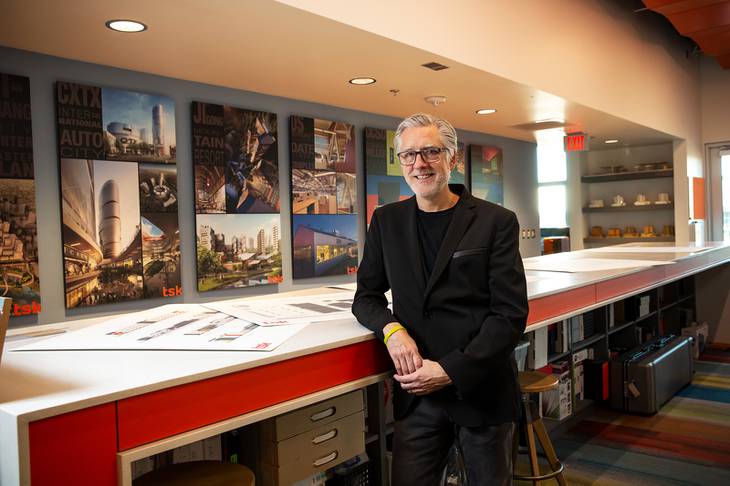Windom Kimsey, principal and CEO of TSK Architects, has had a hand in designing several Southern Nevada buildings that residents would recognize immediately, such as the Regional Justice Center in Las Vegas, the Student Union at UNLV and the Springs Preserve Visitor Center. But airports hold a special place in his heart.
“I love the integration of transportation, technology and design in buildings. Airports are heroic buildings that incorporate the latest technology and innovation in a way that strives to lift the human spirit and celebrates the progress of humankind, much like the grand train stations of the past,” said Kimsey, whose firm designed the D gates at McCarran International Airport.
Kimsey discussed the pandemic’s impact on current and future projects and shared a theoretical curriculum for an architectural tour of Southern Nevada.
When did you discover your passion for architecture?
I visited Cologne cathedral in Germany when I was 14 years old, and discovered how architecture had the power to create emotions. I never wavered in my commitment to become an architect after that.
Describe your approach to building design.
I try to absorb as much information as I can about the site and what the building users need, and how they want to function in their new building. The more informed I can be, the easier the design process is. I work through my first design ideas in sketch form to test them out. My awesome staff work with me to further develop the concepts before we present them to the client. It may start with a singular source but quickly becomes a collaborative effort within our firm.
How has the pandemic affected your business?
It forced our firm to embrace working remotely, but I was surprised how easily our staff adapted. There will be some component of remote working that will stay with us after the pandemic has subsided. We have been lucky to have a steady stream of existing and new work to keep all of our staff employed and have even added a few new people over the past few months.
Do you think COVID-19 will have an influence on new building design or remodels?
There are some features that affect how we touch surfaces — such as faucets and doors — that will be used a lot more to minimize the spread of germs. We might also see some reduction in open office plans. However, spaces for education, transportation and congregation will still be needed for people to interact in. Time will pass and we will return to spaces where people can socialize like they did before the pandemic. It is in our nature as humans to do so.
What research do you do before beginning a new project?
We research previous projects that have the same use and evaluate the good things that work well, and the bad things that do not. We also spend time with the building users and work to understand what they want, what they can afford, and we try to realize that into a design. It is an iterative process that takes some time to get right. Every new design has unique challenges and opportunities.
How has your profession evolved in the past decade?
Mostly in our ability to communicate ideas to better help clients and contractors understand the designs. We use virtual reality to better understand spaces, and building our construction documents in three dimensions helps to identify problems in the digital world before they are realized in the physical world.
What is the best business advice you’ve received?
It is important to believe in your convictions but at the end of the day, we work for our clients — and never be afraid to admit when you are wrong.
If you could take a group of architecture students around Las Vegas on a building tour, where would the first three stops be?
Downtown Henderson, where I live, would show them how a fabric of a community is greater than a singular building and demonstrate how architecture can create a better community. I would also take them for a walking tour of Las Vegas Boulevard, starting downtown and going south, examining the successes and failures of the resort corridor. This is the economic lifeblood of our community and one of the most unique urban spaces in the United States. Lastly, I would take them to Hoover Dam, which was a transformative event for the Las Vegas valley and a very beautiful design that still inspires today.
Where do you see yourself in 5 years?
We’re about halfway through a long-term project that is helping to revitalize downtown Henderson, so I’m looking forward to completing that project in the next five years and developing other exciting opportunities in the Henderson community.
If you could live anywhere else in the world, where would it be and why?
I love Italy and have always dreamed of living part of my life there. You can’t beat the food, the people and the architecture.
